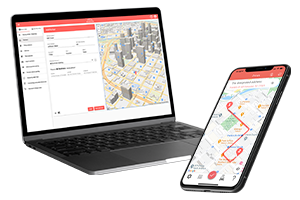Last updated: July 15, 2024
Did you know that there is about 1.3 billion dollars in unclaimed refund in the U.S. for the tax year 2017 alone? Yours might also be there, sitting and waiting for you. If you drive a car for a business purpose, there’s a good chance you are eligible for a mileage tax deduction on your federal income tax return, up to 3 years in retrospect.
In this article, we’ll show you some vital points for your bulletproof business mileage deduction and also how to log miles for taxes.
What’s Your Situation?
Whether you’re looking for a self-employed mileage deduction, you’re reimbursing your employees for their business miles, or you’re a small business owner, you need to create a vehicle mileage log for your business tax return.
There are easier and more difficult ways to them, but first, let’s see the basic differences between the purposes of trips:
Business vs. Personal use: What’s business mileage?
Business use purposes:
- Business meeting/conference
- Driving to a client
- Business lunch with a client
- Going to the post office, bank, or Home Depot for work supplies
- Medical purposes
- Running business-related errands
Personal use purposes:
- Commuting between home and the company’s headquarters
- Doing personal shopping
- Going to a family event
- Driving to the cinema/theatre
- Gym or other sports purposes
It’s vital to know how to log miles for taxes: you need to track both business and personal purposes in your mileage report, so you get the ratio of personal and business trips.
Don’t run into trouble by claiming 100% business use of a vehicle at any cost. Using MileageWise’s AI Wizard feature, you can easily set the ratio of business and personal trips, so you get the best recommendations of forgotten trips retrospectively, auto-populated to fill in the gaps for your 100% IRS-Proof Mileage Log.

How To Log Miles for Taxes Step-By-Step
1. Standard Mileage Rate or Actual Expense Method?
Taxpayers can select a method of calculation. Keep in mind that you cannot change the method in the same year.
- Standard Mileage Deduction: This is the easier way, as you only need to track the number of miles driven in a year for business purposes, then you multiply it by the IRS’s Standard Mileage Rate, which is 67 cents in Tax Year 2024. Based on the average business miles claimed on taxes, it can add up to 12,000 per tax year. While you won’t be able to deduct any specific operational expenses on the car (maintenance, fuel, insurance, etc.), the mileage rate aims to cover those for you.
- Actual Expense Method: If you feel like you can’t get the most out of the standard mileage rate, you can still go with the Actual Expense Method. Although this way gives you the chance to deduct all your car-related business expenses depending on the ratio of your business miles, it takes more time to collect all of the receipts for your repairs, registration fees, refuelings, lease payments, garage rent, depreciation, licenses, insurance, and tires. You must choose this option if you have 5 or more cars. Remember that if you choose this method, you also have to keep copies of all the relevant documentation, such as receipts or bills.
2. Set your odometer readings at the start & end of the tax year
Are you having trouble recollecting your past odometer readings? Using MileageWise, you can easily calculate them by using our Past Odometer Reading Calculator. If you know your very first and your current odometer readings and the actual fuel consumption of your vehicle, you’re good to go.
3. Pen and paper vs. Mileage tracker app & web dashboard
There are several ways to keep track of your business miles: You can create a mileage log on paper, on Google / Excel Sheet, a printable Mileage Log Template or you can use a Mileage Tracker App on your phone – sometimes accompanied by a Web Dashboard.
However, backtracking your business miles to reconstruct your mileage log on paper, especially retrospectively can be extremely difficult. There are countless fixed data and circumstances you have to keep in mind and put into your mileage log very precisely. It is a cheap solution, but at the end of the day, you will certainly ask yourself: Is it worth it?
Even mileage trackers with GPS technology are inexact sometimes because they can only track real-time driving, they cannot be used for reconstructing or creating logs retrospectively.
How to recover my past miles retrospectively?
MileageWise can make up for forgotten mileage logs, even your location history that Google Maps has recorded for you in the background, which you can also transform into an IRS-Proof mileage log via MileageWise – the IRS requires a lot of data that Google simply cannot acquire, you’re gonna need MileageWise as a third party software.
We strongly suggest that you turn on Location History in your Google account, which automatically tracks every one of your trips.
If anything happens in the future, you’ll have your trips in Google Timeline, which you’ll be able to convert into an IRS-Proof mileage log with the help of MileageWise.
With the AI Wizard feature and by checking and correcting 70 logical conflicts your recommended logs will be well-built and IRS-Proof, meeting every expectation.
Having your past mileage logs reconstructed, you can continue tracking your trips with MileageWise manually.
Watch our video about importing trips while recreating your retrospective mileage log:
Can I track mileage on the go?
Absolutely. MileageWise’s Mileage Tracking App has Automatic Tracking based on Real-life drivers’ needs, experiences, and feedback. Furthermore, it has no unnecessary features, so your trips will be detected automatically without using up your Data and Battery.
We value privacy: MileageWise’a mobile app tracks you accurately, while not monitoring your movement constantly, only at the point of your arrival.
On a tight deadline?
Outsource the task of keeping your mileage log to us!



